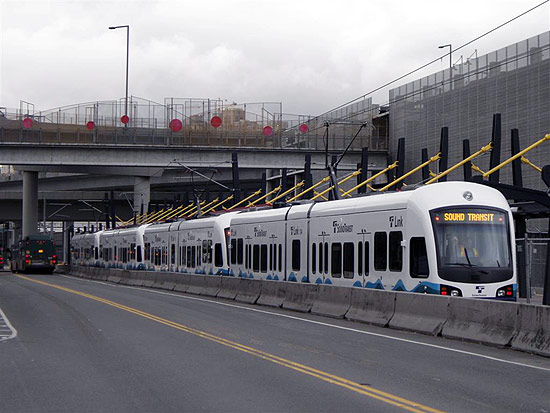from NCPA,
6/11/14:
Cities across the country are building inefficient, expensive light-rail lines, according to a report from Randal O'Toole, senior fellow at the Cato Institute.
The term "light rail" is often mistaken as referring to weight, but in fact, light rail refers to people-moving capacity: light-rail lines provide low-capacity transit but are typically less expensive than higher capacity heavy rail.
The globe has seen an explosion in new rail transit that is somewhat of a hybrid of the two, providing low-capacity transit at high cost:
 - Seattle is in the process of constructing a three-mile subway that costs almost six times as much per mile -- $600 million -- as the average light-rail line, yet it has no more capacity than a light-rail line.
- Similarly, Honolulu is building a 20-mile rail line that is low-capacity yet twice as expensive ($250 million per mile) as standard light-rail.
- A light-rail line currently being constructed in Salt Lake City costs more than $50 million per mile. On average, light rail costs more than $100 million per mile.
- This trend is not just an American one, as high-cost, low-capacity rail has popped up in India, Panama, Brazil and other Asian and Latin American countries.
Moreover, these expensive rail systems are not providing advantages over traditional transit:
- Light-rail trains with three cars can hold up to 450 people, more than a bus. However, most light-rail lines can run only 20 trains per hour. A single bus stop, on the other hand, can serve 42 buses per hour, and, by staggering stops, a street can serve more than 160 buses per hour.
- A bus with 40 seats and standing room for 20 people can move more than 10,000 passengers per hour, more than the 9,000 served by light-rail trains. Double-decker buses can move even more, up to 18,000 people per hour.
- The cost difference between the two is enormous: a double-decker bus costs $650,000, while just one light-rail car costs $4.5 million. Additionally, light-rail requires tracks, which cost more than $50 million per mile to install, in addition to maintenance costs.
The problems with light-rail do not stop with the high costs. Because the costs are so expensive, transit agencies often stop bus service to low-income neighborhoods, making it more difficult for riders to get around.
Why are so many cities signing on to these inefficient projects? A federal fund, known as New Starts, promises to pay a minimum of half the cost of new transit lines, and the more that cities spend, the more federal dollars they get. In short, O'Toole explains, cities are racing to build the most expensive rail lines possible.
- Seattle is in the process of constructing a three-mile subway that costs almost six times as much per mile -- $600 million -- as the average light-rail line, yet it has no more capacity than a light-rail line.
- Similarly, Honolulu is building a 20-mile rail line that is low-capacity yet twice as expensive ($250 million per mile) as standard light-rail.
- A light-rail line currently being constructed in Salt Lake City costs more than $50 million per mile. On average, light rail costs more than $100 million per mile.
- This trend is not just an American one, as high-cost, low-capacity rail has popped up in India, Panama, Brazil and other Asian and Latin American countries.
Moreover, these expensive rail systems are not providing advantages over traditional transit:
- Light-rail trains with three cars can hold up to 450 people, more than a bus. However, most light-rail lines can run only 20 trains per hour. A single bus stop, on the other hand, can serve 42 buses per hour, and, by staggering stops, a street can serve more than 160 buses per hour.
- A bus with 40 seats and standing room for 20 people can move more than 10,000 passengers per hour, more than the 9,000 served by light-rail trains. Double-decker buses can move even more, up to 18,000 people per hour.
- The cost difference between the two is enormous: a double-decker bus costs $650,000, while just one light-rail car costs $4.5 million. Additionally, light-rail requires tracks, which cost more than $50 million per mile to install, in addition to maintenance costs.
The problems with light-rail do not stop with the high costs. Because the costs are so expensive, transit agencies often stop bus service to low-income neighborhoods, making it more difficult for riders to get around.
Why are so many cities signing on to these inefficient projects? A federal fund, known as New Starts, promises to pay a minimum of half the cost of new transit lines, and the more that cities spend, the more federal dollars they get. In short, O'Toole explains, cities are racing to build the most expensive rail lines possible.
More From NCPA:










